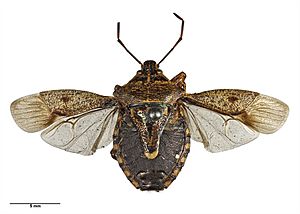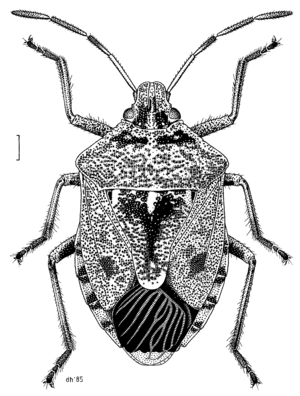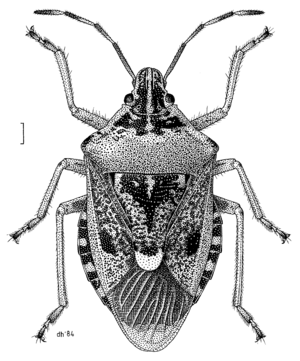Brown soldier bug facts for kids
Quick facts for kids Brown soldier bug |
|
|---|---|
 |
|
| A female Cermatulus nasalis turbotti specimen | |
| Scientific classification | |
| Kingdom: | |
| Phylum: | |
| Class: | |
| Order: | |
| Superfamily: | |
| Family: | |
| Genus: |
Cermatulus
|
| Species: |
C. nasalis
|
| Binomial name | |
| Cermatulus nasalis (Westwood, 1837)
|
|
The brown soldier bug (scientific name: Cermatulus nasalis) is a cool type of shield bug. It's also known as the glossy shield bug. You can find these bugs living naturally in Australia and New Zealand. They are special because they are predators, meaning they hunt other insects for food!
Contents
Meet the Brown Soldier Bug
The brown soldier bug is a fascinating insect. It belongs to a group of bugs called Pentatomidae, which are often called shield bugs because of their shield-like shape.
Different Types of Brown Soldier Bugs
Scientists have found three different types, or subspecies, of the brown soldier bug:
- C. nasalis hudsoni
- C. nasalis nasalis
- C. nasalis turbotti
What Do They Look Like?
Brown soldier bugs have a unique appearance.
- Female bugs are usually between 10.5 and 12.5 millimeters (about 0.4 to 0.5 inches) long.
- Male bugs are a little bit smaller than the females.
- Their heads are brown and have a rounded snout.
- The main part of their body behind the head (called the prothorax) is shaped like a wide triangle. It has tiny holes and is usually yellowish, orange, or rusty brown. It also has black marks and small brownish-black dots.
- The top of their belly is black, while the bottom is a mix of yellowish-brown colors.
- Their front wings are mostly brown, with a large black triangle at the back of each wing.
- Their antennae and legs are yellowish-brown.
Life of a Predator: Ecology
The brown soldier bug is a predator. This means it hunts and eats other insects. It uses its special beak to pierce its prey and then sucks out the body fluids. It's like drinking a smoothie through a straw!
Life Cycle of the Brown Soldier Bug
These bugs have one generation each year.
- Breeding: They breed over several weeks during the summer.
- Eggs: A female bug lays about thirty black eggs. She places them neatly in three rows on a leaf or a piece of bark.
- Nymphs: When the eggs hatch, tiny baby bugs called nymphs appear. They are red with black heads.
- First Meal: At first, these nymphs eat bacteria found on the eggshells. They also drink sap from plants.
- Growing Up: As they grow, the nymphs shed their skin five times. Each time they shed, they are called a new "instar." Each instar has a different pattern of red and black markings.
- Becoming Hunters: After their first molt (from the second instar onwards), they become predators. They start hunting and eating caterpillars and other soft-bodied insects.
Images for kids






